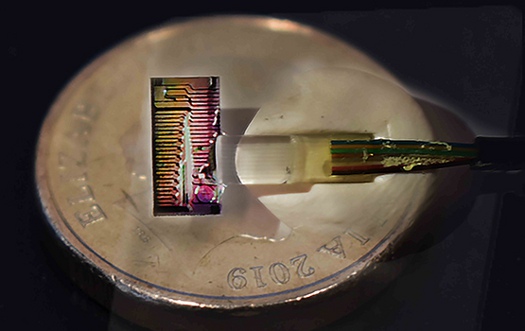 |
| May 26, 2020 | Volume 16 Issue 20 |
Designfax weekly eMagazine
Archives
Partners
Manufacturing Center
Product Spotlight
Modern Applications News
Metalworking Ideas For
Today's Job Shops
Tooling and Production
Strategies for large
metalworking plants
44.2 Tbps! World's fastest internet speed from a single optical chip

Researchers from Monash, Swinburne, and RMIT universities have recorded the world's fastest internet speed from a single optical chip, which has the capacity to support the high-speed internet connections of millions of households at the same time.
Researchers from Monash, Swinburne, and RMIT universities in Australia have successfully tested and recorded the fastest internet data speed from a single optical chip -- capable of downloading 1,000 high-def movies in a split second.
Published in the international journal Nature Communications, these findings have the potential to not only fast-track the next 25 years of Australia's telecommunications capacity, but also the possibility for this home-grown technology to be rolled out across the world.
In light of the pressures being placed on the world's internet infrastructure, recently highlighted by isolation policies as a result of COVID-19, the research team led by Dr. Bill Corcoran (Monash), Distinguished Professor Arnan Mitchell (RMIT), and Professor David Moss (Swinburne) were able to achieve a data speed of 44.2 Terabits per second (Tbps) from a single light source.
This technology has the capacity to support the high-speed internet connections of 1.8 million households in Melbourne, Australia, at the same time, and billions across the world during peak periods.
Demonstrations of this magnitude are usually confined to a laboratory. But, for this study, researchers achieved these quick speeds using existing communications infrastructure where they were able to efficiently load-test the network.
They used a new device that replaces 80 lasers with one single piece of equipment known as a micro-comb, which is smaller and lighter than existing telecommunications hardware. It was planted into and load-tested using existing infrastructure, which mirrors that used by Australia's National Broadband Network (NBN).
It is the first time any micro-comb has been used in a field trial and possesses the highest amount of data produced from a single optical chip.
"We're currently getting a sneak peek of how the infrastructure for the internet will hold up in two to three years' time, due to the unprecedented number of people using the internet for remote work, socializing and streaming. It's really showing us that we need to be able to scale the capacity of our internet connections," said Corcoran, co-lead author of the study and Lecturer in Electrical and Computer Systems Engineering at Monash University.
"What our research demonstrates is the ability for fibers that we already have in the ground, thanks to the NBN project, to be the backbone of communications networks now and in the future. We've developed something that is scalable to meet future needs," he said.
"And it's not just Netflix we're talking about here -- it's the broader scale of what we use our communication networks for. This data can be used for self-driving cars and future transportation, and it can help the medicine, education, finance and e-commerce industries, as well as enable us to read with our grandchildren from kilometers away."
To illustrate the impact optical micro-combs have on optimizing communication systems, researchers installed 76.6 km of "dark" optical fibers between RMIT's Melbourne City Campus and Monash University's Clayton Campus. The optical fibers were provided by Australia's Academic Research Network.
Within these fibers, researchers placed the micro-comb -- contributed by Swinburne University, as part of a broad international collaboration -- which acts like a rainbow made up of hundreds of high-quality infrared lasers from a single chip. Each "laser" has the capacity to be used as a separate communications channel.
Researchers were able to send maximum data down each channel, simulating peak internet usage, across 4 THz of bandwidth.
Mitchell said reaching the optimum data speed of 44.2 Tbps showed the potential of existing Australian infrastructure. The future ambition of the project is to scale up the current transmitters from hundreds of gigabytes per second to tens of terabytes per second without increasing size, weight, or cost.
"Long-term, we hope to create integrated photonic chips that could enable this sort of data rate to be achieved across existing optical fiber links with minimal cost," Mitchell said.
"Initially, these would be attractive for ultra-high-speed communications between data centers. However, we could imagine this technology becoming sufficiently low cost and compact that it could be deployed for commercial use by the general public in cities across the world."
Moss, Director of the Optical Sciences Center at Swinburne University, said, "In the 10 years since I co-invented micro-comb chips, they have become an enormously important field of research.
"It is truly exciting to see their capability in ultra-high-bandwidth fiber optic telecommunications coming to fruition. This work represents a world record for bandwidth down a single optical fiber from a single chip source, and represents an enormous breakthrough for part of the network which does the heaviest lifting. Micro-combs offer enormous promise for us to meet the world's insatiable demand for bandwidth."
Source: Monash University
Published May 2020
Rate this article
View our terms of use and privacy policy
